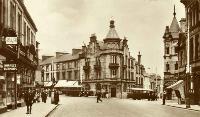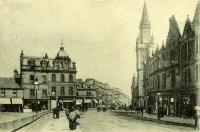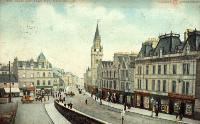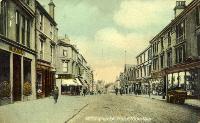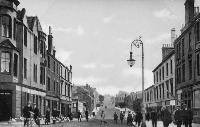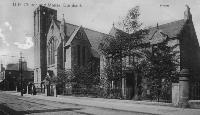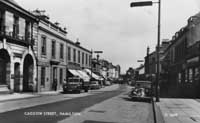Hamilton Parish
Information specific to this area can be found below and on the left
menu bar. We also recommend consulting the many general pages for
information of general relevance to miners' lives.
Below: Cadzow St
Ordnance Gazetteer of Scotland, Francis H Groome, 1885
Hamilton, a royal, parliamentary, and police burgh, and a parish in the middle ward of Lanarkshire. The town is situated in the midst of a pleasantly diversifed region, sloping on the whole to the east-north-eastward, and about 1 mile WSW of the junction of the Avon and the Clyde. It stands adjacent to the Glasgow, Hamilton, and Strathaven railway, 2 miles WSW of the railway junction at Motherwell, 9 3/4 miles by railway and 10 3/4 by road SE of Glasgow, and 36 by road WSW of Edinburgh. The environs present a pretty undulating landscape, with fine woods and picturesque dells through which three burns run to the Clyde and six to the Avon. The outskirts are extensive, and comprise numerous handsome villas and mansions, besides remains of older historical houses. The original town occupied a site within the Duke of Hamilton's park, to the ENE of the present position, and bore the name of Netherton. The oldest parts of the present town stand near the public green, and date from the early part of the 15th century, but they have undergone considerable improvement in more modern times. The main thoroughfare of the newer part, a street about 700 yards long, was laid out in 1835, and is carried 60 feet above the bed of Cadzow Burn by Cadzow bridge, which is supported on 3 spans of 60 feet each. The suburbs, though well-built, are somewhat straggling and irregular in plan. The Burgh Buildings were erected near the centre of the town in 1861-63. They are built in the modernised Scotch Baronial style, with a clock-tower nearly 130 feet high; and they contain a public hall 63 feet long by 36 wide, besides smaller halls and official apartments. The County Buildings, classical in style, stand upon high ground towards the W end of the town. Originally founded in June 1834, they have been subsequently enlarged; and they contain a county hall besides various county offices. Immediately adjacent is the prison (disused since 1882), which, with an airing ground of half an acre, is surrounded by a high wall. Erected at the same time as the County Buildings, it superseded the older prison, which stood in the lower part of the town, now included in the ducal park. This old prison is adorned with a steeple, and dates from the time of Charles I ; it was dismantled about 1834, but in 1861 was repaired by the Duke of Hamilton. The Trades' Hall was built in 1816; became prior to 1865 the property of the Young Men's Christian Association; and is now used for meetings and as a reading-room. The barracks, formerly used for cavalry, but now solely for infantry, stand near the County Buildings, and occupy a large space of ground enclosed by a high wall. The railway from Glasgow and Strathaven has its terminus at Hamilton in the new Central station, from which also runs the Lesmahagow line; and the Bothwell and Hamilton station occupies a spacious site nearly opposite the Roman Catholic church. The corporation gas-work was erected in 1831 at a cost of £2400, and is on an elegant plan. A water supply by gravitation was introduced into the town, under authority of Act of Parliament in 1853. The parish church occupies a site upon high ground, and, though originally beyond the town to the S, is now embraced by the town extension. It was built in 1732 from designs by the elder Adam, and consists of a circlear body with four cross aisles, and has a fine stained glass window by the Messrs Ballantine, representing our Lord and Martha and Mary, placed there in 1876 in memory of Mrs James Stevenson. It contains about 800 sittings. Auchingramont Established church was built in 1860, has 900 sittings, and ranks as a collegiate charge with the parish church, the two ministers preaching alternately in the two churches. The stipends of these two churches are the same, viz., £412; but the former has a glebe of 36 acres, valued at £82, and the latter a manse, valued at £30. Cadzow quoad sacra church, containing 800 sittings, was built in 1876-77 at a cost considerably exceeding the estimate, £4000. St John's Free church is a modern edifice with 1000 sittings. Burnbank Free church, erected in 1875 at a cost of nearly £3000, contained 600 sittings, and was built for the use of the mining population of Greenfield and other villages. It was, however, pulled down, and its site occupied by the new West Free church, which was opened in May 1882, and provides accommodation for 650, at a cost of £4000. Its style is 14th century Gothic, and the spire is 100 feet high. There are four United Presbyterian churches in Hamilton, containing respectively 1105, 940, 700, and 582 sittings. The memorial-stone of a fifth was laid at Burnbank on 2 Dec 1882. Built at a cost of over £3000, and seating 562, this is an Early Gothic edifice with a spire 127 feet high. The Congregational chapel, a neat Gothic building with 362 sittings, was built in 1872 at a cost of £1400, to supersede a former chapel in Campbell Street. The Evangelical Union chapel contains 250 sittings, and St Mary's Roman Catholic church, built in 1846, has 500. The Episcopal church, dedicated to St Mary, is an Early Pointed structure of 1849, and can accommodate 330 hearers. The burgh school board consists of a chairman and eight members. In Sept 1881 the following were the five schools under the burgh school board, with accommodation, average attendance, and government grant: Beckford Street public (350, 336, £300, 19s.); Townhead public (400, 362, £316, 15s); Orphan and Charity (365, 312, £262) ; St John's Free church (618, 586, £605, 4s.); and St Mary's Roman Catholic (304, 409, £327, 4s). The academy is an old foundation, and till 1714 stood near the old churchyard adjoining the palace. It was rebuilt by Anne, Duchess of Hamilton, in Grammar Square, and again in 1848 removed to a new site. It includes a rector's residence, with room for 10 or 12 boarders. Other schools are St John's grammar school for boys, a boarding-school for girls, and several adventure schools. The Mechanics' Institute was founded in 1846, and has a library. The Subscription Library, established in 1808 chiefly through the exertions of Dr John Hume, is now extinct. The Duke's Hospital is an old building, with a belfry and bell, situated at the Cross, and erected in lieu of the former one, which stood in the Netherton. The pensioners do not now reside here; but it contributes to the support of a dozen old men, at the rate of £8, 18s. yearly, with a suit of clothes biennially. Aikman's Hospital in Muir Street, was built and endowed in 1775, by Mr Aikman, a proprietor in the parish, and formerly a merchant in Leghorn. Four old men are here lodged, have £4 per annum, and a suit of clothes every two years. Rae's, Robertson's, and Lyon's, and Miss Christian Allan's mortifications also produce considerable sums for the support of the poor, and some other funds have been placed at the disposal of the kirk-session for similar purposes. Other institutions are a choral union, an agricultural society, an auxiliary Bible society, and a variety of economical, philanthropic, religious, and other associations. Besides a savings' bank at the post office, Hamilton contains branches of the Bank of Scotland, British Linen Company's Bank, the Clydesdale, Commercial, Royal, and Union Banks, and 29 insurance companies are represented by agents or offices within the town. The Hamilton Advertiser (1856) is published every Saturday. Hamilton, though it carries on a large amount of local trade, has no manufactures of importance. A manufacture of lace was early introduced by one of the duchesses of Hamilton, afterwards Duchess of Argyll, who brought over a native of France to teach it; and, as it was esteemed, in the circumstances, fully more a noble than a plebeian thing, many respectable females, who had no need of it as an avocation, became pupils and workers. The Hamilton lace was long in repute among the higher classes, but eventually went out of fashion. But about 1835 the manufacture of a sort of tamboured bobinette was introduced as a substitute for it; and this rose suddenly into such importance that within eight years upwards of 2500 females in the town or neighbourhood were employed upon it. The making of check shirts for the colonial market, and the making of black silk veils of peculiar patterns, also rose rapidly into importance. The imitation of cambric weaving of the finest kinds took its chief seat at Hamilton after the introduction of the cotton trade into Scotland; and it prospered so much that whole streets of houses were built to accommodate the industrious weavers, no fewer than about 1250 looms being in the town; but about 1815 or 1820 it began to decline, and not many years afterwards it reached a point where it could yield a sustenance only a degree or two above starvation. Now, however, the industries of the town include some cotton-weaving, coach-building, iron and brass founding, besides the ordinary handicrafts. Hamilton was made a burgh of barony in 1456, and a royal burgh in 1548. Subsequently it resigned its rights and privileges as a royal burgh, and was created a burgh of regality in 1668 by charter of Charles II. to Anna, Duchess of Hamilton. After the Reform Act of 1832 it became a parliamentary burgh. Prior to 1871 it adopted the General Police and Improvement Act of 1862, and in 1878 the municipal burgh was extended. It is governed by a provost, 4 bailies, a treasurer, and 10 councillors. The corporation income was (1832) £654, (1865) £1237, and (1882) £7324. The burgh police force numbers 19 men, the superintendent receiving a salary of £110. The burgh unites with Falkirk, Airdrie, Lanark, and Linlithgow in returning one member to parliament. In 1883 the parliamentary constituency was 1518, and the municipal 1756 (including 238 females). Sheriff courts are held at Hamilton every Tuesday and Friday for ordinary business; and for small-debt business every Friday. Small debt justice of peace courts are held every Monday, and the magistrates sit in the burgh court as required. A weekly market is held on Friday, and special markets for cattle and hiring are held on the third Fridays of April and October. Valuation, including railways (1872), £30,020, (1876) £37,195, (1882-83) £76, 900. Pop. of parliamentary burgh (1841), 8724, (1851) 9630, (1861) 10,688, (1871) 11,498, (1881) 13,995, of whom 6988 were females. Pop. of police burgh and town (1871) 11,498, (1881) 18,517, of whom 9066 were females and 22 Gaelic-speaking. Houses (1881) inhabited 3557, vacant 653, building 65. Cadzow Castle was the original capital of Hamilton parish, and gave name to it till 1445, when, in virtue of a charter from James II. to the first Lord Hamilton, the present name superseded the older one of Cadyhou, Cadyow, or Cadzow. Soon afterwards the old town of Netherton came to be called Hamilton also. Queen Mary, on her way from Loch Leven Castle to Langside, held a court at Cadzow Castle, and rested at a spot in the town still called Queenzie Neuk. The forces appointed by Cromwell to overawe the West of Scotland in 1650, took post at Hamilton under General Lambert. There they sustained a momentary defeat from a force of 1500 Covenanters from Ayrshire, and General Lambert was captured before his men, sallying, repulsed the attack. Cromwell himself, on visiting the town, lodged at the King's Head Inn, now demolished. The victors at the Battle of Drumclog, both before and after their advance towards Glasgow, marched to Hamilton; and the more moderate of them drew up a defence in explanation of their conduct, which came to be known as the 'Hamilton Declaration.' The fugitives from the battle of Bothwell Bridge, fought 1 1/2 mile NNW, fled in all directions through the parish of Hamilton, where 1200 were captured. Many escaped through hiding in the woods of Hamilton Park, where they were generously protected by Anne, Duchess of Hamilton. William Cullen, M. D. (1710-90), was a native of Hamilton; Thomas, Lord Cochrane, tenth Earl of Dundonald (1775-1860), author of Autobiography of a Seaman, spent many of his early years in the neighbourhood; and John Anderson (1789-1832) resided at Hamilton from 1819, and wrote Historical and Genealogical Memoirs of the Hamiltons (2 vols., 1835-27). The father of Professor Millar of Glasgow, and the father of Dr Baillie and Joanna Baillie, were ministers of Hamilton. The parish of Hamilton, situated in the middle ward of Lanarkshire, is bounded on the N by Bothwell, on the NE and E by Dalziel. on the SE by Dalserf, on the S by Stonehouse, on the SW by Glassford, on the W by Glassford and Blantyre, and on the NW by Blantyre. Its longest axis extends 6 miles from NNW to SSE; its greatest breadth, at right angles to that, is 5 1/2 miles; and its total area is 14,243 acres, of which 160 are water. The Clyde traces the NE and N border for nearly 5 miles; the Avon has a course of 3 1/2 miles along the ESE of the parish, to a confluence with the Clyde about a mile from the town; and nine burns rise on or near the S or W border, and run mostly NE, six to the Avon and three to the Clyde. The N district, forming a broad band along the Clyde, is a low sheltered valley; the middle district, traversed by the Avon, is diversified and beautiful; while the southern district rises gradually to elevations of from 580 to 750 feet above sea-level. The rocks are extensively of the Carboniferous formation. Sandstone is raised in several quarries, limestone is worked at Earnockmuir and Boghead, and ironstone at Boghead and Quarter. By far the most important mineral is coal, the excavation of which affords occupation to a very large number of the population. There are coal mines at Merriton, High Merriton, Dykehead, Bog, Allanton, Ferniegair, Haughhead, Quarter, and Greenfield. The soil on the low grounds is for the most part alluvial or loam; on the higher districts gravelly or moorland. About 8000 acres are arable, 100 are in orchards, 2000 under wood, 2100 occupied by water, towns, and roads, and the remainder pasture or waste land. The chief industry is coal mining, though of course farming occupies many hands .The other industries are mentioned in connection with the town. Hamilton is the only burgh; the parish also contains the villages of Allanton, Darngaber, Ferniegair, Quarter, and Low Waters; and parts of the towns of Motherwell and Larkhall. The chief proprietor in the parish is the Duke of Hamilton, besides whom 16 proprietors hold each an annual value of £500 and upwards, 87 of between £100 and £500, 105 of from £50 to £100, and 160 of from £20 to £50. The chief seats are Hamilton Palace, Earnock House, Grovemount, Ross, Fairhill, Nielsland, Fairholm, and Edlewood. Other mansions, once of note, are Allanshaw, Darngaber, Merriton, and Udston. The chief antiquities are those in Hamilton town and park, and Cadzow Castle, Darngaber Castle, Barncluith Gardens, Meikle Earnock tumulus, and an oblique standing stone in the S of the parish called the 'Crooked Stane' Hamilton is in the synod of Glasgow and Ayr, and gives name to a presbytery. Besides the churches mentioned above, there is a chapel of ease at Quarter. In Sept. 1881 the following were the 6 public schools under the landward school-board, with their respective accommodation, average attendance, and government grants; Beechfield (150, 43, £35, 8s.), Ferniegair (250, 136, £96, 10s.), Greenfield (655, 501, £424, 7s.), Low Waters (431, 305, £266, 17s. 6d.), Motherwell (250, 307, £262, 1s.), and Quarter (250, 236, £216, 9s.). Valuation (1860) £36,243, (1880) £88,204, (1883) £113,752. Pop. of civil parish (1801) 5911, (1831) 7613, (1841) 10,862, (1871) 16, 803, (1881) 26, 231, of whom 18,645 were in Hamilton ecclesiastical parish, 7163 in Cadzow, 63 in Chapelton, and 360 in Larkhall.
Ferniegair, a village, with a station in Hamilton parish, Lanarkshire, on the Lesmahagow railway, at the junction of the eastward line from Hamilton, 2 1/4 miles NNW of Larkhall. Pop. (1871) 395, (1881) 551.
Allanton, a coal mining village, in Hamilton parish, Lanarkshire, 1 3/4 mile ESE of the town. Pop. (1871) 301
Darngaber, a village in Hamilton parish, Lanarkshire, near Quarter Road station, and 3 miles S of Hamilton town.
Low Waters, a village in Hamilton parish, Lanarkshire, 1 mile SSW of the town.
